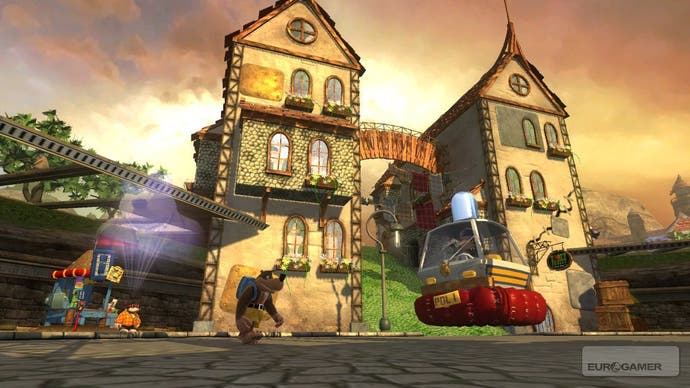Banjo-Kazooie: Nuts & Bolts
We visit Rare and play single-player and multiplayer.
Sadly, we are unable to settle the debate. We may have been invited to Rare to play Banjo-Kazooie: Nuts & Bolts last week, but we cannot definitively confirm what percentage is platforming and what percentage is racing. Apart from being impossible to quantify, this is because - after several hours of egg-and-spoon races in shopping trolleys and playing darts with soapbox racers and a ski-jump - we don't care. You too will get over it, we suspect, once you've spent a few minutes in the vehicle editor.
Editing tools - particularly vehicle editors - have become more popular with the advent of hard disk-based consoles, but complexity often relegates them to an afterthought for the average gamer. Many of us loved Forza Motorsport 2, but how many spent hours designing a perfect car, and how many got bored and just browsed a few on the internet and played the game instead? It's important that Banjo doesn't overwhelm the player, or no one will use the editor, and it doesn't. Even in an ageing build of the now nearly-finished game, complete with incorrect button prompts and lying menus, we quickly learn how to arrange blocks, wedges, engines, guns and gadgets in 3D space to create cars, boats and planes.
But it's equally important it doesn't go too far the other way and stifle, and Banjo doesn't do this either. The main limitation is a block-based 3D grid, but a multitude of parts, wedges, corners and other ornaments offset the constriction. With the nucleus of an idea, it's possible for us to arrange a flat plane of blocks looping artistically into an "EG", with jet engines above and below, upside-down Union Jacks, and a serrated edge along the bottom (sadly we couldn't write "2287 Comments" on it). It's simple to select and move individual parts, or delete them, and a series of expandable menus provide access to whatever you've unlocked. There's plenty of room to create and elaborate.

The decision to enforce clear visual divisions between blocks and items, and rule out complex colour schemes and decals, will likely prove more controversial, but - as with LEGO bricks and other similar toys - being able to play with your creations is not only adequate recompense, but defines new creative goals. One of the missions Banjo and Kazooie undertake, for example, is to hurl a vehicle off a ramp and land in craters positioned around a stadium to amass points, but no amount of propulsion seems to reach to the end, until you realise you can create detachable nosecones and loose them at the peak of the jump. Figuring out a good barrel shape and then watching it tumble across the terrain is certainly more interesting than designing a car and then using bumper-cam anyway.
It's in this way, of course, that Rare hopes Nuts & Bolts will achieve the developers' professed goal of greater replayability; by allowing you to better your previous attempts by tweaking the original vehicle design, or by creating something entirely new. But it's not just the promise of a better time and maybe a medal that will encourage players to explore these activities; the requisite Xbox Live leaderboards post new times, and replays, but most interestingly, as long as the player hasn't deselected the option, they post blueprints for the leading vehicle and allow others to download them. Unlike PGR4, where an average player might view a top time and realise he or she can never perform at that level, an average Banjo player will be able to act as mechanic instead and top the charts not by weight of skill, but by weight of imagination. Even if the blueprint is withheld, a quick scan of the replay video should give away the secrets.
It's a compelling concept, but as a single-player game Nuts & Bolts must also satisfy the Banjo faithful, returning to relive glories not so much former as faded. So, like Super Mario, Ratchet & Clank and Jak & Daxter before it, progress is made by collecting special items (in this case jigsaw pieces) obtained at the completion of a wide variety of tasks, many of which involve vehicles, accessed from a 3D world.







